BOSS delay pedals are legendary in the world of stompboxes. From the classic analog delay of the DM-2 Delay, to the world’s first digital delay pedal in the DD-2 Digital Delay and through to today with the unique TE-2 Tera Echo, BOSS have continually provided artists with delay pedals that deliver exceptional results.
Guitar players, bass players, keyboard, synth and countless other musicians are among the legion of BOSS delay users, with BOSS pedals seen and heard on stages, studios and recordings around the globe.
Continuing this legacy of groundbreaking delay units, the DD-500 Digital Delay incorporates over 30 years of digital delay expertise, with unsurpassed sonic quality to become, by far, the most powerful and versatile delay pedal ever produced by BOSS.
In fact, such is the audio quality and flexibility of this advanced pedal that it has swiftly risen through the ranks of the effects pedal world, to establish itself as one of the finest delay pedals on the market today.
While any musician can use the DD-500 quite easily and get great results, it definitely has features that set it apart from a standard “plug-in and play” delay pedal.
So in this article, we’ll explore the DD-500 and outline what makes it the most powerful delay pedal available today.
Contributed by Byron Struck for the Roland Australia Blog
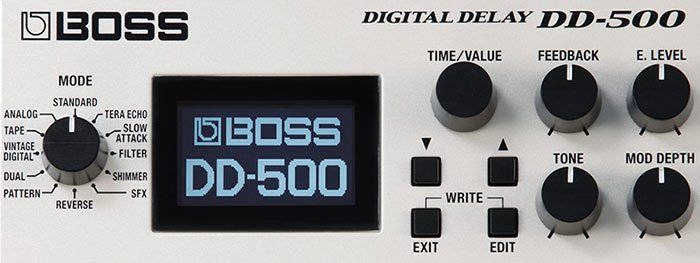 The DD-500 Digital Delay is unsurpassed in its deep-editing functionality, however it’s also highly useable in that the most common delay parameters are easily tweakable, via the top panel knobs.
The DD-500 has six rotary knobs for parameter control and selection. From left to right, these are:
MODE: Selects which kind of delay you’d like to use. As you can see, the types of delay appear in a circular layout for easy and quick selection.
TIME/VALUE: This control adjusts the time of the delay that you have selected. Delay time refers to the time (in milliseconds/seconds) between each repeat of the delayed signal.
FEEDBACK: Controls the amount of repeats in the delay signal.
E. LEVEL: Adjusts the volume of the effect, allows you to dial in as much or as little delay sound as you’d like.
MOD DEPTH: This control adjusts how deep the modulation of the delayed signal will be. Modulation refers to changes that occur to a signal over a certain time period. This effect is more apparent on certain types of delay, which we’ll get to later.
TONE: Similar to an EQ control, this adjusts the frequency spectrum of the effect sound. The response is flat and unaffected when the knob is set to centre (a.k.a. 12 o’clock). Higher frequencies are boosted when the knob is turned to the right and cut when the knob is turned to the left.
DELAY TIME, FEEDBACK, EFFECT LEVEL and TONE are all manually adjustable with just the twist of a knob at any time. Even the MODULATION DEPTH (which imparts a subtle chorusing effect) is easily adjustable on any patch at any time.
The large LCD readout makes detailed sound editing simple and understandable. It also shows critical information, such as Delay Time and BPM tempo, along with the patch memory number and name.
Different delay sounds are able to be created, edited and stored as a patch in the DD-500’s internal memory. The DD-500 can store up to 297 individual patches.
The DD-500 Digital Delay is unsurpassed in its deep-editing functionality, however it’s also highly useable in that the most common delay parameters are easily tweakable, via the top panel knobs.
The DD-500 has six rotary knobs for parameter control and selection. From left to right, these are:
MODE: Selects which kind of delay you’d like to use. As you can see, the types of delay appear in a circular layout for easy and quick selection.
TIME/VALUE: This control adjusts the time of the delay that you have selected. Delay time refers to the time (in milliseconds/seconds) between each repeat of the delayed signal.
FEEDBACK: Controls the amount of repeats in the delay signal.
E. LEVEL: Adjusts the volume of the effect, allows you to dial in as much or as little delay sound as you’d like.
MOD DEPTH: This control adjusts how deep the modulation of the delayed signal will be. Modulation refers to changes that occur to a signal over a certain time period. This effect is more apparent on certain types of delay, which we’ll get to later.
TONE: Similar to an EQ control, this adjusts the frequency spectrum of the effect sound. The response is flat and unaffected when the knob is set to centre (a.k.a. 12 o’clock). Higher frequencies are boosted when the knob is turned to the right and cut when the knob is turned to the left.
DELAY TIME, FEEDBACK, EFFECT LEVEL and TONE are all manually adjustable with just the twist of a knob at any time. Even the MODULATION DEPTH (which imparts a subtle chorusing effect) is easily adjustable on any patch at any time.
The large LCD readout makes detailed sound editing simple and understandable. It also shows critical information, such as Delay Time and BPM tempo, along with the patch memory number and name.
Different delay sounds are able to be created, edited and stored as a patch in the DD-500’s internal memory. The DD-500 can store up to 297 individual patches.
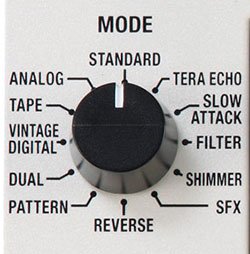 The DD-500 has 12 onboard delay modes, providing a diverse and nuanced range of options with which to customise your sound.
From the crystal clear digital delay of the STANDARD mode, to the smooth, rising soundscapes offered through the SLOW ATTACK setting, you’ll be able to tap into cutting edge modern sounds along with beloved vintage tones.
ANALOG and TAPE faithfully replicate classic BOSS and Roland units like the DM-2 Delay and RE-201 Space Echo respectively, while VINTAGE DIGITAL gives you the warm, crisp sound of the legendary DD-2 Digital Delay, the world’s first digital delay pedal released by BOSS in 1984.
Staying true to the legacy of innovation that BOSS have maintained over the decades, the TERA ECHO mode gives you one of the most exciting new delay sounds of recent years, with a lively and animated ambient wash that merges reverb, echo, delay, pitch-shifting and modulation in exciting new dimensions.
FILTER mode gives you a wide, sweeping modulation delay while SHIMMER will make your clean arpeggios ring as its pitching fluctuations work their charm on your delay signal.
SFX allows you to bring sci-fi inspired sounds into your music with its Bit Crushing capabilities and you can hear everything you play backwards with the REVERSE mode!
DUAL allows you to use two independent, simultaneous delay sounds and finally, PATTERN gives you a step sequencing path for your delay to follow, allowing for a pulsating, undulating signal that is perfect for rhythmic melody lines.
Another fantastic function of the DD-500 is the A+B operation mode (available in the Global Settings). This allows you to use two delay patches simultaneously, in series or parallel. As such, you can create and combine sounds for stellar results.
For example, let’s say you have a particular ANALOG patch that you’re fond of. Something that adds a bit of depth to your sound for a cool, spatial widening. You also have a TERA ECHO patch that you want to use to bring a certain edge to your sound.
Keeping the ANALOG patch active, you can also bring the TERA ECHO patch in whenever you like, to add that extra dimension to your signal!
Use any patch you like with A+B mode for fantastic possibilities. Reverse your Filter delay, Shimmer your SFX, Slow Attack your Tape…you get the idea.
The DD-500 has 12 onboard delay modes, providing a diverse and nuanced range of options with which to customise your sound.
From the crystal clear digital delay of the STANDARD mode, to the smooth, rising soundscapes offered through the SLOW ATTACK setting, you’ll be able to tap into cutting edge modern sounds along with beloved vintage tones.
ANALOG and TAPE faithfully replicate classic BOSS and Roland units like the DM-2 Delay and RE-201 Space Echo respectively, while VINTAGE DIGITAL gives you the warm, crisp sound of the legendary DD-2 Digital Delay, the world’s first digital delay pedal released by BOSS in 1984.
Staying true to the legacy of innovation that BOSS have maintained over the decades, the TERA ECHO mode gives you one of the most exciting new delay sounds of recent years, with a lively and animated ambient wash that merges reverb, echo, delay, pitch-shifting and modulation in exciting new dimensions.
FILTER mode gives you a wide, sweeping modulation delay while SHIMMER will make your clean arpeggios ring as its pitching fluctuations work their charm on your delay signal.
SFX allows you to bring sci-fi inspired sounds into your music with its Bit Crushing capabilities and you can hear everything you play backwards with the REVERSE mode!
DUAL allows you to use two independent, simultaneous delay sounds and finally, PATTERN gives you a step sequencing path for your delay to follow, allowing for a pulsating, undulating signal that is perfect for rhythmic melody lines.
Another fantastic function of the DD-500 is the A+B operation mode (available in the Global Settings). This allows you to use two delay patches simultaneously, in series or parallel. As such, you can create and combine sounds for stellar results.
For example, let’s say you have a particular ANALOG patch that you’re fond of. Something that adds a bit of depth to your sound for a cool, spatial widening. You also have a TERA ECHO patch that you want to use to bring a certain edge to your sound.
Keeping the ANALOG patch active, you can also bring the TERA ECHO patch in whenever you like, to add that extra dimension to your signal!
Use any patch you like with A+B mode for fantastic possibilities. Reverse your Filter delay, Shimmer your SFX, Slow Attack your Tape…you get the idea.
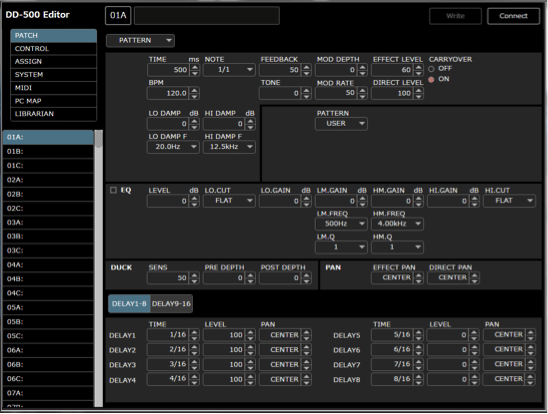 While the DD-500 is certainly not short on parameter tweaking abilities, the deep features can sometimes make working with the small screen slightly challenging.
As such, using the editor to create and store your patches and then simply tweaking the unit as you need to on-the-fly can help to simplify patch editing with the DD-500.
While the DD-500 is certainly not short on parameter tweaking abilities, the deep features can sometimes make working with the small screen slightly challenging.
As such, using the editor to create and store your patches and then simply tweaking the unit as you need to on-the-fly can help to simplify patch editing with the DD-500.
 The three footswitches on the front of the DD-500 (A/B/C or TAP/CTL), offer you a variety of options.
Aside from basic operations like turning the unit on or off, switching delay patches, tap tempo and shifting banks, the footswitches are assignable to control delay parameters and features that will add extra flair and dimension to your delay sounds.
The TAP/CTL switch is particularly useful for this task if you’ve selected a patch from A or B.
Let’s take a closer look at the features that the TAP/CTL switch can command.
HOLD: True to its name, this feature will repeat your delay sound for as long as you hold down the switch.
WARP: Warp is a great feature for controlling both the feedback level and volume of your delay at the same time.
TWIST: The Twist feature is a newer development from BOSS, which creates a fast-rising, “lift-off” kind of sound and it really does sound like you’re twisting your delay signal!
MOMENT: A very useful feature for instantaneous usability, your delay sound will only be output when you press the CTL footswitch.
ROLL (1/2, 1/4, 1/8): Another great way to add variety to your existing delay sound, the Roll features will cut your delay time according to whichever type you choose.
FADE IN: Fading in your delay sound is really cool. Like the Slow Attack mode, you can bring in the signal gradually, for a droning kind of result or to subtly incorporate a delay into your playing.
FADE OUT: A fade out is great for ending a song, merging into a new delay patch or letting your delay sound wash away dramatically.
The three footswitches on the front of the DD-500 (A/B/C or TAP/CTL), offer you a variety of options.
Aside from basic operations like turning the unit on or off, switching delay patches, tap tempo and shifting banks, the footswitches are assignable to control delay parameters and features that will add extra flair and dimension to your delay sounds.
The TAP/CTL switch is particularly useful for this task if you’ve selected a patch from A or B.
Let’s take a closer look at the features that the TAP/CTL switch can command.
HOLD: True to its name, this feature will repeat your delay sound for as long as you hold down the switch.
WARP: Warp is a great feature for controlling both the feedback level and volume of your delay at the same time.
TWIST: The Twist feature is a newer development from BOSS, which creates a fast-rising, “lift-off” kind of sound and it really does sound like you’re twisting your delay signal!
MOMENT: A very useful feature for instantaneous usability, your delay sound will only be output when you press the CTL footswitch.
ROLL (1/2, 1/4, 1/8): Another great way to add variety to your existing delay sound, the Roll features will cut your delay time according to whichever type you choose.
FADE IN: Fading in your delay sound is really cool. Like the Slow Attack mode, you can bring in the signal gradually, for a droning kind of result or to subtly incorporate a delay into your playing.
FADE OUT: A fade out is great for ending a song, merging into a new delay patch or letting your delay sound wash away dramatically.
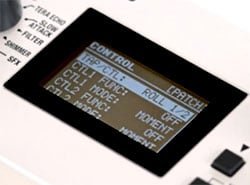 If using TAP TEMPO or CTL functions doesn’t appeal to you, the DD-500 offers the ability to re-assign the TAP/CTL footswitch to be a third patch selection button – allowing instant access to 3 patches within a single bank.
The footswitches also control the Phrase Looper, a powerful built-in feature of the DD-500. If you’ve ever used any of BOSS’ Loop Station pedals then you’ll be familiar with the concept and action of looping with a pedal. If you’ve never looped before – welcome to a new level of sound creation!
Looping allows you to record a portion of your playing, repeat it indefinitely and record more layers on top of it – which also repeat indefinitely! Like any BOSS looper, you have the ability to record an infinite amount of loop overdubs.
The Phrase Looper operates in both Mono and Stereo, so you can really take advantage of the stereo field if you choose. Check out the following chart for more info.
If using TAP TEMPO or CTL functions doesn’t appeal to you, the DD-500 offers the ability to re-assign the TAP/CTL footswitch to be a third patch selection button – allowing instant access to 3 patches within a single bank.
The footswitches also control the Phrase Looper, a powerful built-in feature of the DD-500. If you’ve ever used any of BOSS’ Loop Station pedals then you’ll be familiar with the concept and action of looping with a pedal. If you’ve never looped before – welcome to a new level of sound creation!
Looping allows you to record a portion of your playing, repeat it indefinitely and record more layers on top of it – which also repeat indefinitely! Like any BOSS looper, you have the ability to record an infinite amount of loop overdubs.
The Phrase Looper operates in both Mono and Stereo, so you can really take advantage of the stereo field if you choose. Check out the following chart for more info.
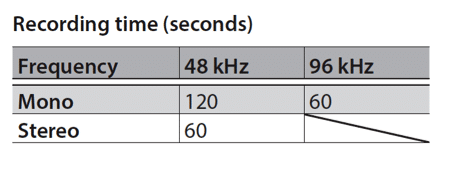
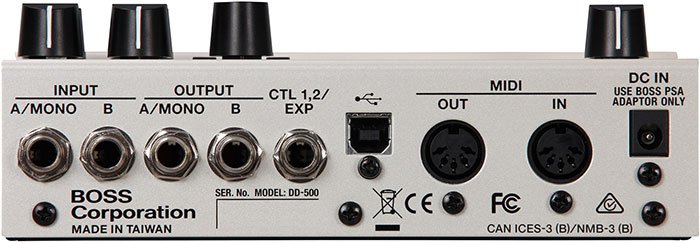 MIDI (Musical Instrument Digital Interface) is a digital protocol that allows electronic instruments and gear to communicate effectively with each other.
The DD-500 is equipped with both MIDI IN and OUT ports, meaning that not only can it be controlled by other pieces of gear but it can itself act as a controller for other MIDI gear.
Using MIDI PC (Program Change), you can use another piece of MIDI-equipped gear to remotely change the patches of your DD-500.
This is extremely useful when incorporating the DD-500 into a pedal rig controlled by a switcher, such as the BOSS ES-8 Effects Switching System.
Using this setup, you can program the ES-8 to instantly recall different patches from the DD-500, with no need to touch the DD-500 at all!
MIDI (Musical Instrument Digital Interface) is a digital protocol that allows electronic instruments and gear to communicate effectively with each other.
The DD-500 is equipped with both MIDI IN and OUT ports, meaning that not only can it be controlled by other pieces of gear but it can itself act as a controller for other MIDI gear.
Using MIDI PC (Program Change), you can use another piece of MIDI-equipped gear to remotely change the patches of your DD-500.
This is extremely useful when incorporating the DD-500 into a pedal rig controlled by a switcher, such as the BOSS ES-8 Effects Switching System.
Using this setup, you can program the ES-8 to instantly recall different patches from the DD-500, with no need to touch the DD-500 at all!
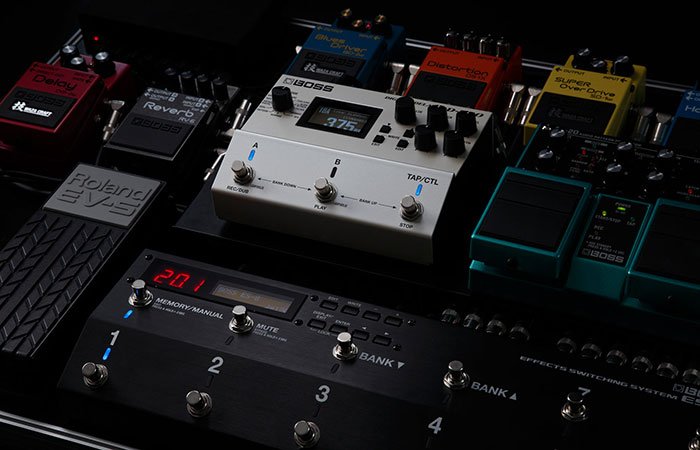 MIDI Tempo Sync allows the DD-500 to either broadcast or receive tempo information from other devices. This means that external loopers, sequencers….or even lighting controllers are all ready to be MIDI synced to operate at the same tempo as the DD-500.
MIDI CC (Control Change) allows the adjustment of ANY delay parameter in real time, using external MIDI controllers.
If you don’t have access to any MIDI devices, the DD-500 still offers a massive amount of assignable control. Control pedals like the BOSS FS-7 or EV-30 can provide you with an excellent means to add additional control to the DD-500 patches.
Reassigning the control functions of the DD-500’s footswitches allows an external control pedal to take on the parameters that you would normally use the DD-500’s switches for, thus expanding the level of flexibility on offer. Of course, you can, in fact, assign the external footswitches to control anything you like.
As you can see, the BOSS DD-500 is an exceptionally powerful delay unit with outstanding sound quality. When used with a guitar, bass, synthesizer, keyboard or other instruments, you have processing power that is at the highest end of hardware equipment available today.
For studio use, the DD-500 will give you near-unlimited creative options when used in conjunction with your hardware, software or instruments.
Onstage, the DD-500 provides fantastic usability and sound, rapid, simple editing and an unobtrusive, lightweight portability.
Best of all, it’s reliable and will work its charm for you and your sound again and again!
…and again and again and again and again…
MIDI Tempo Sync allows the DD-500 to either broadcast or receive tempo information from other devices. This means that external loopers, sequencers….or even lighting controllers are all ready to be MIDI synced to operate at the same tempo as the DD-500.
MIDI CC (Control Change) allows the adjustment of ANY delay parameter in real time, using external MIDI controllers.
If you don’t have access to any MIDI devices, the DD-500 still offers a massive amount of assignable control. Control pedals like the BOSS FS-7 or EV-30 can provide you with an excellent means to add additional control to the DD-500 patches.
Reassigning the control functions of the DD-500’s footswitches allows an external control pedal to take on the parameters that you would normally use the DD-500’s switches for, thus expanding the level of flexibility on offer. Of course, you can, in fact, assign the external footswitches to control anything you like.
As you can see, the BOSS DD-500 is an exceptionally powerful delay unit with outstanding sound quality. When used with a guitar, bass, synthesizer, keyboard or other instruments, you have processing power that is at the highest end of hardware equipment available today.
For studio use, the DD-500 will give you near-unlimited creative options when used in conjunction with your hardware, software or instruments.
Onstage, the DD-500 provides fantastic usability and sound, rapid, simple editing and an unobtrusive, lightweight portability.
Best of all, it’s reliable and will work its charm for you and your sound again and again!
…and again and again and again and again…
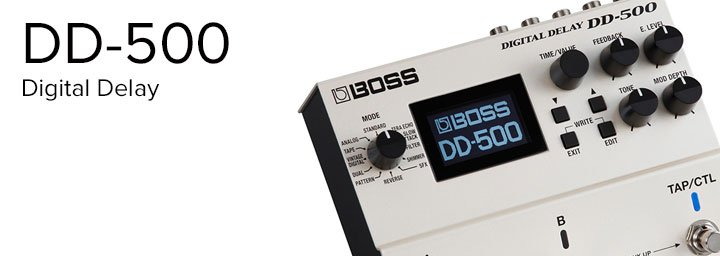
PURE REPETITION
Perhaps the single greatest feature of the DD-500 is its exceptional audio quality. In terms of pure audio processing ability, the DD-500 ranks much more highly than almost any pedal out there. While even the most sought-after, high-end, boutique delay pedals operate at 24-bit/48kHz sampling rates, the DD-500 operates at an astounding 32-bit/96kHz. The result is quite simple – your guitar’s delayed tone repeats in pristine, detailed audio quality, with an almost 3-dimensional aspect. Amazingly, the DD-500 keeps your “dry” (unaffected) input sound within a 100% analog signal path throughout the pedal, meaning that your fundamental tone remains pure and unprocessed. To suit all guitar players, the DD-500 offers the option of either true bypass, or buffered bypass when the pedal is disengaged. True Bypass takes the DD-500 completely out of the signal chain, while buffered bypass strengthens your guitar signal and allows it to travel through long cable lengths with no loss of fidelity. With buffered bypass selected, this also enables effect carryover and ensures that delay trails don’t get cut off when the effect is switched off, or over to another patch. This function can also be defeated if you prefer. Thanks to the DD-500’s high-resolution signal processing, the integrity of your input sound will maintain its sonic quality, while the powerful DSP engine works to provide you, in pristine quality, with lush, warm and rich sounding delays, no matter how long you want them to last!CONTROL YOURSELF
 The DD-500 Digital Delay is unsurpassed in its deep-editing functionality, however it’s also highly useable in that the most common delay parameters are easily tweakable, via the top panel knobs.
The DD-500 has six rotary knobs for parameter control and selection. From left to right, these are:
MODE: Selects which kind of delay you’d like to use. As you can see, the types of delay appear in a circular layout for easy and quick selection.
TIME/VALUE: This control adjusts the time of the delay that you have selected. Delay time refers to the time (in milliseconds/seconds) between each repeat of the delayed signal.
FEEDBACK: Controls the amount of repeats in the delay signal.
E. LEVEL: Adjusts the volume of the effect, allows you to dial in as much or as little delay sound as you’d like.
MOD DEPTH: This control adjusts how deep the modulation of the delayed signal will be. Modulation refers to changes that occur to a signal over a certain time period. This effect is more apparent on certain types of delay, which we’ll get to later.
TONE: Similar to an EQ control, this adjusts the frequency spectrum of the effect sound. The response is flat and unaffected when the knob is set to centre (a.k.a. 12 o’clock). Higher frequencies are boosted when the knob is turned to the right and cut when the knob is turned to the left.
DELAY TIME, FEEDBACK, EFFECT LEVEL and TONE are all manually adjustable with just the twist of a knob at any time. Even the MODULATION DEPTH (which imparts a subtle chorusing effect) is easily adjustable on any patch at any time.
The large LCD readout makes detailed sound editing simple and understandable. It also shows critical information, such as Delay Time and BPM tempo, along with the patch memory number and name.
Different delay sounds are able to be created, edited and stored as a patch in the DD-500’s internal memory. The DD-500 can store up to 297 individual patches.
The DD-500 Digital Delay is unsurpassed in its deep-editing functionality, however it’s also highly useable in that the most common delay parameters are easily tweakable, via the top panel knobs.
The DD-500 has six rotary knobs for parameter control and selection. From left to right, these are:
MODE: Selects which kind of delay you’d like to use. As you can see, the types of delay appear in a circular layout for easy and quick selection.
TIME/VALUE: This control adjusts the time of the delay that you have selected. Delay time refers to the time (in milliseconds/seconds) between each repeat of the delayed signal.
FEEDBACK: Controls the amount of repeats in the delay signal.
E. LEVEL: Adjusts the volume of the effect, allows you to dial in as much or as little delay sound as you’d like.
MOD DEPTH: This control adjusts how deep the modulation of the delayed signal will be. Modulation refers to changes that occur to a signal over a certain time period. This effect is more apparent on certain types of delay, which we’ll get to later.
TONE: Similar to an EQ control, this adjusts the frequency spectrum of the effect sound. The response is flat and unaffected when the knob is set to centre (a.k.a. 12 o’clock). Higher frequencies are boosted when the knob is turned to the right and cut when the knob is turned to the left.
DELAY TIME, FEEDBACK, EFFECT LEVEL and TONE are all manually adjustable with just the twist of a knob at any time. Even the MODULATION DEPTH (which imparts a subtle chorusing effect) is easily adjustable on any patch at any time.
The large LCD readout makes detailed sound editing simple and understandable. It also shows critical information, such as Delay Time and BPM tempo, along with the patch memory number and name.
Different delay sounds are able to be created, edited and stored as a patch in the DD-500’s internal memory. The DD-500 can store up to 297 individual patches.
GOING MODAL
 The DD-500 has 12 onboard delay modes, providing a diverse and nuanced range of options with which to customise your sound.
From the crystal clear digital delay of the STANDARD mode, to the smooth, rising soundscapes offered through the SLOW ATTACK setting, you’ll be able to tap into cutting edge modern sounds along with beloved vintage tones.
ANALOG and TAPE faithfully replicate classic BOSS and Roland units like the DM-2 Delay and RE-201 Space Echo respectively, while VINTAGE DIGITAL gives you the warm, crisp sound of the legendary DD-2 Digital Delay, the world’s first digital delay pedal released by BOSS in 1984.
Staying true to the legacy of innovation that BOSS have maintained over the decades, the TERA ECHO mode gives you one of the most exciting new delay sounds of recent years, with a lively and animated ambient wash that merges reverb, echo, delay, pitch-shifting and modulation in exciting new dimensions.
FILTER mode gives you a wide, sweeping modulation delay while SHIMMER will make your clean arpeggios ring as its pitching fluctuations work their charm on your delay signal.
SFX allows you to bring sci-fi inspired sounds into your music with its Bit Crushing capabilities and you can hear everything you play backwards with the REVERSE mode!
DUAL allows you to use two independent, simultaneous delay sounds and finally, PATTERN gives you a step sequencing path for your delay to follow, allowing for a pulsating, undulating signal that is perfect for rhythmic melody lines.
Another fantastic function of the DD-500 is the A+B operation mode (available in the Global Settings). This allows you to use two delay patches simultaneously, in series or parallel. As such, you can create and combine sounds for stellar results.
For example, let’s say you have a particular ANALOG patch that you’re fond of. Something that adds a bit of depth to your sound for a cool, spatial widening. You also have a TERA ECHO patch that you want to use to bring a certain edge to your sound.
Keeping the ANALOG patch active, you can also bring the TERA ECHO patch in whenever you like, to add that extra dimension to your signal!
Use any patch you like with A+B mode for fantastic possibilities. Reverse your Filter delay, Shimmer your SFX, Slow Attack your Tape…you get the idea.
The DD-500 has 12 onboard delay modes, providing a diverse and nuanced range of options with which to customise your sound.
From the crystal clear digital delay of the STANDARD mode, to the smooth, rising soundscapes offered through the SLOW ATTACK setting, you’ll be able to tap into cutting edge modern sounds along with beloved vintage tones.
ANALOG and TAPE faithfully replicate classic BOSS and Roland units like the DM-2 Delay and RE-201 Space Echo respectively, while VINTAGE DIGITAL gives you the warm, crisp sound of the legendary DD-2 Digital Delay, the world’s first digital delay pedal released by BOSS in 1984.
Staying true to the legacy of innovation that BOSS have maintained over the decades, the TERA ECHO mode gives you one of the most exciting new delay sounds of recent years, with a lively and animated ambient wash that merges reverb, echo, delay, pitch-shifting and modulation in exciting new dimensions.
FILTER mode gives you a wide, sweeping modulation delay while SHIMMER will make your clean arpeggios ring as its pitching fluctuations work their charm on your delay signal.
SFX allows you to bring sci-fi inspired sounds into your music with its Bit Crushing capabilities and you can hear everything you play backwards with the REVERSE mode!
DUAL allows you to use two independent, simultaneous delay sounds and finally, PATTERN gives you a step sequencing path for your delay to follow, allowing for a pulsating, undulating signal that is perfect for rhythmic melody lines.
Another fantastic function of the DD-500 is the A+B operation mode (available in the Global Settings). This allows you to use two delay patches simultaneously, in series or parallel. As such, you can create and combine sounds for stellar results.
For example, let’s say you have a particular ANALOG patch that you’re fond of. Something that adds a bit of depth to your sound for a cool, spatial widening. You also have a TERA ECHO patch that you want to use to bring a certain edge to your sound.
Keeping the ANALOG patch active, you can also bring the TERA ECHO patch in whenever you like, to add that extra dimension to your signal!
Use any patch you like with A+B mode for fantastic possibilities. Reverse your Filter delay, Shimmer your SFX, Slow Attack your Tape…you get the idea.
ON SCREEN
Recently released, the DD-500’s Software Editor is an indispensable tool for creating, editing, storing and transferring patches from your computer into the DD-500. With this editor, all of the DD-500’s parameters have visual representation on your computer screen. You can use the editor to dial up specific settings for a patch, as you would on the actual unit, except in a far more user-friendly way. While the DD-500 is certainly not short on parameter tweaking abilities, the deep features can sometimes make working with the small screen slightly challenging.
As such, using the editor to create and store your patches and then simply tweaking the unit as you need to on-the-fly can help to simplify patch editing with the DD-500.
While the DD-500 is certainly not short on parameter tweaking abilities, the deep features can sometimes make working with the small screen slightly challenging.
As such, using the editor to create and store your patches and then simply tweaking the unit as you need to on-the-fly can help to simplify patch editing with the DD-500.
SWITCH IT UP
 The three footswitches on the front of the DD-500 (A/B/C or TAP/CTL), offer you a variety of options.
Aside from basic operations like turning the unit on or off, switching delay patches, tap tempo and shifting banks, the footswitches are assignable to control delay parameters and features that will add extra flair and dimension to your delay sounds.
The TAP/CTL switch is particularly useful for this task if you’ve selected a patch from A or B.
Let’s take a closer look at the features that the TAP/CTL switch can command.
HOLD: True to its name, this feature will repeat your delay sound for as long as you hold down the switch.
WARP: Warp is a great feature for controlling both the feedback level and volume of your delay at the same time.
TWIST: The Twist feature is a newer development from BOSS, which creates a fast-rising, “lift-off” kind of sound and it really does sound like you’re twisting your delay signal!
MOMENT: A very useful feature for instantaneous usability, your delay sound will only be output when you press the CTL footswitch.
ROLL (1/2, 1/4, 1/8): Another great way to add variety to your existing delay sound, the Roll features will cut your delay time according to whichever type you choose.
FADE IN: Fading in your delay sound is really cool. Like the Slow Attack mode, you can bring in the signal gradually, for a droning kind of result or to subtly incorporate a delay into your playing.
FADE OUT: A fade out is great for ending a song, merging into a new delay patch or letting your delay sound wash away dramatically.
The three footswitches on the front of the DD-500 (A/B/C or TAP/CTL), offer you a variety of options.
Aside from basic operations like turning the unit on or off, switching delay patches, tap tempo and shifting banks, the footswitches are assignable to control delay parameters and features that will add extra flair and dimension to your delay sounds.
The TAP/CTL switch is particularly useful for this task if you’ve selected a patch from A or B.
Let’s take a closer look at the features that the TAP/CTL switch can command.
HOLD: True to its name, this feature will repeat your delay sound for as long as you hold down the switch.
WARP: Warp is a great feature for controlling both the feedback level and volume of your delay at the same time.
TWIST: The Twist feature is a newer development from BOSS, which creates a fast-rising, “lift-off” kind of sound and it really does sound like you’re twisting your delay signal!
MOMENT: A very useful feature for instantaneous usability, your delay sound will only be output when you press the CTL footswitch.
ROLL (1/2, 1/4, 1/8): Another great way to add variety to your existing delay sound, the Roll features will cut your delay time according to whichever type you choose.
FADE IN: Fading in your delay sound is really cool. Like the Slow Attack mode, you can bring in the signal gradually, for a droning kind of result or to subtly incorporate a delay into your playing.
FADE OUT: A fade out is great for ending a song, merging into a new delay patch or letting your delay sound wash away dramatically.
 If using TAP TEMPO or CTL functions doesn’t appeal to you, the DD-500 offers the ability to re-assign the TAP/CTL footswitch to be a third patch selection button – allowing instant access to 3 patches within a single bank.
The footswitches also control the Phrase Looper, a powerful built-in feature of the DD-500. If you’ve ever used any of BOSS’ Loop Station pedals then you’ll be familiar with the concept and action of looping with a pedal. If you’ve never looped before – welcome to a new level of sound creation!
Looping allows you to record a portion of your playing, repeat it indefinitely and record more layers on top of it – which also repeat indefinitely! Like any BOSS looper, you have the ability to record an infinite amount of loop overdubs.
The Phrase Looper operates in both Mono and Stereo, so you can really take advantage of the stereo field if you choose. Check out the following chart for more info.
If using TAP TEMPO or CTL functions doesn’t appeal to you, the DD-500 offers the ability to re-assign the TAP/CTL footswitch to be a third patch selection button – allowing instant access to 3 patches within a single bank.
The footswitches also control the Phrase Looper, a powerful built-in feature of the DD-500. If you’ve ever used any of BOSS’ Loop Station pedals then you’ll be familiar with the concept and action of looping with a pedal. If you’ve never looped before – welcome to a new level of sound creation!
Looping allows you to record a portion of your playing, repeat it indefinitely and record more layers on top of it – which also repeat indefinitely! Like any BOSS looper, you have the ability to record an infinite amount of loop overdubs.
The Phrase Looper operates in both Mono and Stereo, so you can really take advantage of the stereo field if you choose. Check out the following chart for more info.

CONTROL IS NOT LIMITED
 MIDI (Musical Instrument Digital Interface) is a digital protocol that allows electronic instruments and gear to communicate effectively with each other.
The DD-500 is equipped with both MIDI IN and OUT ports, meaning that not only can it be controlled by other pieces of gear but it can itself act as a controller for other MIDI gear.
Using MIDI PC (Program Change), you can use another piece of MIDI-equipped gear to remotely change the patches of your DD-500.
This is extremely useful when incorporating the DD-500 into a pedal rig controlled by a switcher, such as the BOSS ES-8 Effects Switching System.
Using this setup, you can program the ES-8 to instantly recall different patches from the DD-500, with no need to touch the DD-500 at all!
MIDI (Musical Instrument Digital Interface) is a digital protocol that allows electronic instruments and gear to communicate effectively with each other.
The DD-500 is equipped with both MIDI IN and OUT ports, meaning that not only can it be controlled by other pieces of gear but it can itself act as a controller for other MIDI gear.
Using MIDI PC (Program Change), you can use another piece of MIDI-equipped gear to remotely change the patches of your DD-500.
This is extremely useful when incorporating the DD-500 into a pedal rig controlled by a switcher, such as the BOSS ES-8 Effects Switching System.
Using this setup, you can program the ES-8 to instantly recall different patches from the DD-500, with no need to touch the DD-500 at all!
 MIDI Tempo Sync allows the DD-500 to either broadcast or receive tempo information from other devices. This means that external loopers, sequencers….or even lighting controllers are all ready to be MIDI synced to operate at the same tempo as the DD-500.
MIDI CC (Control Change) allows the adjustment of ANY delay parameter in real time, using external MIDI controllers.
If you don’t have access to any MIDI devices, the DD-500 still offers a massive amount of assignable control. Control pedals like the BOSS FS-7 or EV-30 can provide you with an excellent means to add additional control to the DD-500 patches.
Reassigning the control functions of the DD-500’s footswitches allows an external control pedal to take on the parameters that you would normally use the DD-500’s switches for, thus expanding the level of flexibility on offer. Of course, you can, in fact, assign the external footswitches to control anything you like.
As you can see, the BOSS DD-500 is an exceptionally powerful delay unit with outstanding sound quality. When used with a guitar, bass, synthesizer, keyboard or other instruments, you have processing power that is at the highest end of hardware equipment available today.
For studio use, the DD-500 will give you near-unlimited creative options when used in conjunction with your hardware, software or instruments.
Onstage, the DD-500 provides fantastic usability and sound, rapid, simple editing and an unobtrusive, lightweight portability.
Best of all, it’s reliable and will work its charm for you and your sound again and again!
…and again and again and again and again…
MIDI Tempo Sync allows the DD-500 to either broadcast or receive tempo information from other devices. This means that external loopers, sequencers….or even lighting controllers are all ready to be MIDI synced to operate at the same tempo as the DD-500.
MIDI CC (Control Change) allows the adjustment of ANY delay parameter in real time, using external MIDI controllers.
If you don’t have access to any MIDI devices, the DD-500 still offers a massive amount of assignable control. Control pedals like the BOSS FS-7 or EV-30 can provide you with an excellent means to add additional control to the DD-500 patches.
Reassigning the control functions of the DD-500’s footswitches allows an external control pedal to take on the parameters that you would normally use the DD-500’s switches for, thus expanding the level of flexibility on offer. Of course, you can, in fact, assign the external footswitches to control anything you like.
As you can see, the BOSS DD-500 is an exceptionally powerful delay unit with outstanding sound quality. When used with a guitar, bass, synthesizer, keyboard or other instruments, you have processing power that is at the highest end of hardware equipment available today.
For studio use, the DD-500 will give you near-unlimited creative options when used in conjunction with your hardware, software or instruments.
Onstage, the DD-500 provides fantastic usability and sound, rapid, simple editing and an unobtrusive, lightweight portability.
Best of all, it’s reliable and will work its charm for you and your sound again and again!
…and again and again and again and again…
Related Articles
TAKE CONTROL WITH THE ES-8 SWITCHING SYSTEM EVOLUTION OF THE ROLAND SPACE ECHO THE ULTIMATE GUIDE TO BOSS LOOP STATIONS BOSS TALK: I LOVE ANALOG DELAY BUT WHAT IS A BBD? BOSS CULT CLASSICS ECHOES IN TIME: THE HISTORY OF BOSS DELAY PEDALS DEMYSTIFYING THE MAGIC OF TAPE ECHO BOSS PEDALS OF THE PROS BOSS TALK: REVERB FOR GUITARISTS THE ULTIMATE GUIDE TO THE BOSS ES-5 EFFECTS SWITCHING SYSTEM HOW TO ORDER YOUR EFFECTS CHAIN: IT’S EASY WITH MULTI EFFECTSRelated Products




